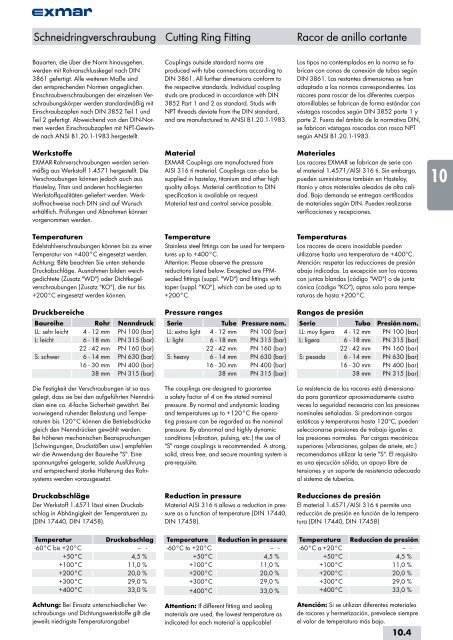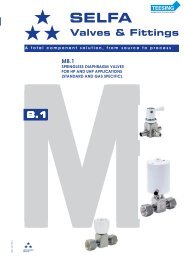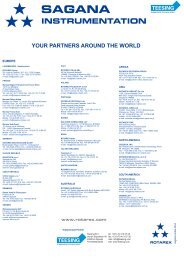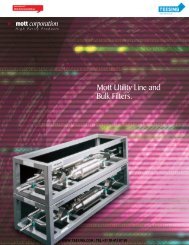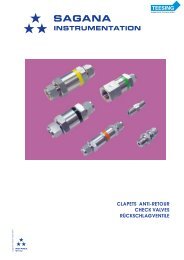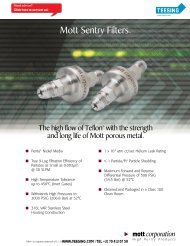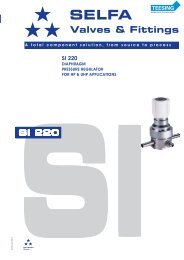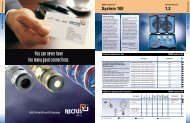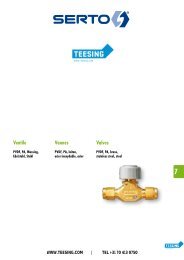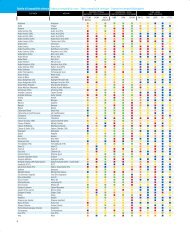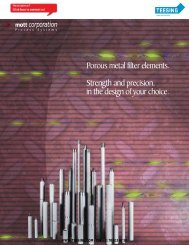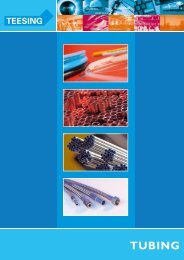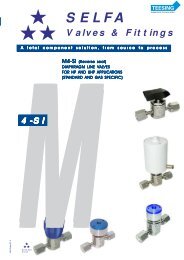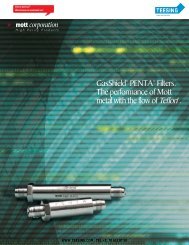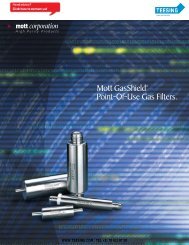Edelstahl Verbindungstechnik Stainless steel jointing technology ...
Edelstahl Verbindungstechnik Stainless steel jointing technology ...
Edelstahl Verbindungstechnik Stainless steel jointing technology ...
- No tags were found...
Create successful ePaper yourself
Turn your PDF publications into a flip-book with our unique Google optimized e-Paper software.
Schneidringverschraubung Cutting Ring FittingRacor de anillo cortanteBauarten, die über die Norm hinausgehen,werden mit Rohranschlusskegel nach DIN3861 gefertigt. Alle weiteren Maße sindden entsprechenden Normen angeglichen.Einschraubverschraubungen der einzelnen Verschraubungskörperwerden standardmäßig mitEinschraubzapfen nach DIN 3852 Teil 1 undTeil 2 gefertigt. Abweichend von den DIN-Normenwerden Einschraubzapfen mit NPT-Gewindenach ANSI B1.20.1-1983 hergestellt.Couplings outside standard norms areproduced with tube connections according toDIN 3861. All further dimensions conform tothe respective standards. Individual couplingstuds are produced in accordance with DIN3852 Part 1 and 2 as standard. Studs withNPT threads deviate from the DIN standard,and are manufactured to ANSI B1.20.1-1983.Los tipos no contemplados en la norma se fabricancon conos de conexión de tubos segúnDIN 3861. Las restantes dimensiones se hanadaptado a las normas correspondientes. Losracores para roscar de los diferentes cuerposatornillables se fabrican de forma estándar convástagos roscados según DIN 3852 parte 1 yparte 2. Fuera del ámbito de la normativa DIN,se fabrican vástagos roscados con rosca NPTsegún ANSI B1.20.1-1983.isWerkstoffeEXMAR-Rohrverschraubungen werden serienmäßigaus Werkstoff 1.4571 hergestellt. DieVerschraubungen können jedoch auch ausHasteloy, Titan und anderen hochlegiertenWerkstoffqualitäten geliefert werden. Werkstoffnachweisenach DIN sind auf Wunscherhältlich. Prüfungen und Abnahmen könnenvorgenommen werden.Temperaturen<strong>Edelstahl</strong>verschraubungen können bis zu einerTemperatur von +400°C eingesetzt werden.Achtung: Bitte beachten Sie unten stehendeDruckabschläge. Ausnahmen bilden weichgedichtete(Zusatz "WD") oder Dichtkegelverschraubungen(Zusatz "KO"), die nur bis+200°C eingesetzt werden können.MaterialEXMAR Couplings are manufactured fromAISI 316 ti material. Couplings can also besupplied in hasteloy, titanium and other highquality alloys. Material certification to DINspecification is available on request.Material test and control service possible.Temperature<strong>Stainless</strong> <strong>steel</strong> fittings can be used for temperaturesup to +400°C.Attention: Please observe the pressurereductions listed below. Excepted are FPMsealedfittings (suppl. "WD") and fittings withtaper (suppl. "KO"), which can be used up to+200°C.MaterialesLos racores EXMAR se fabrican de serie conel material 1.4571/AISI 316 ti. Sin embargo,pueden suministrarse también en Hasteloy,titanio y otros materiales aleados de alta calidad.Bajo demanda se entregan certificadosde materiales según DIN. Pueden realizarseverificaciones y recepciones.TemperaturasLos racores de acero inoxidable puedenutilizarse hasta una temperatura de +400ºC.Atención: respetar las reducciones de presiónabajo indicadas. La excepción son los racorescon juntas blandas (código "WD") o de juntacónica (código "KO"), aptos solo para temperaturasde hasta +200°C.102030DruckbereicheBaureihe Rohr NenndruckLL: sehr leicht 4 - 12 mm PN 100 (bar)L: leicht 6 - 18 mm PN 315 (bar)22 - 42 mm PN 160 (bar)S: schwer 6 - 14 mm PN 630 (bar)16 - 30 mm PN 400 (bar)38 mm PN 315 (bar)Die Festigkeit der Verschraubungen ist so ausgelegt,dass sie bei den aufgeführten Nenndrückeneine ca. 4-fache Sicherheit gewährt. Beivorwiegend ruhender Belastung und Temperaturenbis 120°C können die Betriebsdrückegleich den Nenndrücken gewählt werden.Bei höheren mechanischen Beanspruchungen(Schwingungen, Druckstößen usw.) empfehlenwir die Anwendung der Baureihe "S". Einespannungsfrei gelagerte, solide Ausführungund entsprechend starke Halterung des Rohrsystemswerden vorausgesetzt.DruckabschlägeDer Werkstoff 1.4571 lässt einen Druckabschlagin Abhängigkeit der Temperaturen zu(DIN 17440, DIN 17458).Pressure rangesSerieTube Pressure nom.LL: extra light 4 - 12 mm PN 100 (bar)L: light 6 - 18 mm PN 315 (bar)22 - 42 mm PN 160 (bar)S: heavy 6 - 14 mm PN 630 (bar)16 - 30 mm PN 400 (bar)38 mm PN 315 (bar)The couplings are designed to guaranteea safety factor of 4 on the stated nominalpressure. By normal and undynamic loadingand temperatures up to +120°C the operatingpressure can be regarded as the nominalpressure. By abnormal and highly dynamicconditions (vibration, pulsing, etc.) the use of"S" range couplings is recommended. A strong,solid, stress free, and secure mounting system ispre-requisite.Reduction in pressureMaterial AISI 316 ti allows a reduction in pressureas a function of temperature (DIN 17440,DIN 17458).Rangos de presiónSerie Tubo Presión nom.LL: muy ligera 4 - 12 mm PN 100 (bar)L: ligera 6 - 18 mm PN 315 (bar)22 - 42 mm PN 160 (bar)S: pesada 6 - 14 mm PN 630 (bar)16 - 30 mm PN 400 (bar)38 mm PN 315 (bar)La resistencia de los racores está dimensionadapara garantizar aproximadamente cuatroveces la seguridad necesaria con las presionesnominales señaladas. Si predominan cargasestáticas y temperaturas hasta 120ºC, puedenseleccionarse presiones de trabajo iguales alas presiones normales. Par cargas mecánicassuperiores (vibraciones, golpes de ariete, etc.)recomendamos utilizar la serie "S". El requisitoes una ejecución sólida, un apoyo libre detensiones y un soporte de resistencia adecuadoal sistema de tuberías.Reducciones de presiónEl material 1.4571/AISI 316 ti permite unareducción de presión en función de la temperatura(DIN 17440, DIN 17458)40506070Temperatur Druckabschlag-60°C bis +20°C -- -+50°C 4,5 %+100°C 11,0 %+200°C 20,0 %+300°C 29,0 %+400°C 33,0 %Achtung: Bei Einsatz unterschiedlicher Verschraubungs-und Dichtungswerkstoffe gilt diejeweils niedrigste Temperaturangabe!Temperature Reduction in pressure-60°C to +20°C -- -+50°C 4,5 %+100°C 11,0 %+200°C 20,0 %+300°C 29,0 %+400°C 33,0 %Attention: If different fitting and sealingmaterials are used, the lowest temperature asindicated for each material is applicable!Temperatura Reduccion de presión-60°C a +20°C -- -+50°C 4,5 %+100°C 11,0 %+200°C 20,0 %+300°C 29,0 %+400°C 33,0 %Atención: Si se utilizan diferentes materialesde racores y hermetización, prevalece siempreel valor de temperatura más bajo.10.480a


